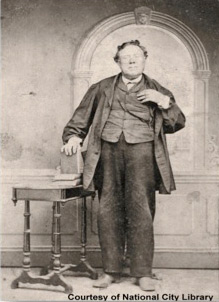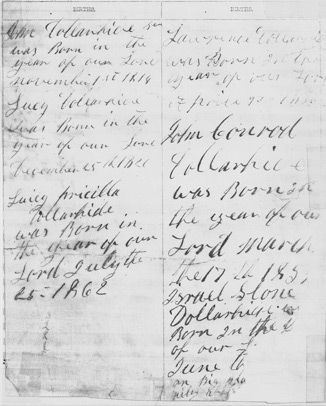The following article was written by my friend, William Dollarhide:

Dollarhide’s Genealogy Rule No. 46: The family Bible you need was inherited by a female descendant of your ancestor, but one who married and divorced at least four times, and whose final surname is a complete mystery.
The First Printed Bibles
Johann Gutenberg introduced printing with moveable type to Western Europe in 1454. The first complete book he printed with the new moveable type system was the Bible, printed in Latin. In 2000, Gutenberg was named the “Man of the Millennium,” by Time Magazine. Gutenberg’s technology allowed the written word to be reproduced and disseminated quickly, cheaply, and in enormous quantities. In less than fifty years after the printing of the first Gutenberg Bible, more than ten million printed books had been produced.
Martin Luther, leader of the German Protestant Reformation, sought to place the Bible into the hands of ordinary Christians. He translated it from Latin — the language of scholars and clergy — into the Fraktur script of the German language. The Bible of Martin Luther was first printed at Wittenberg by Hans Lufft in 1534. Lufft sold over 100,000 copies of Luther’s Bible, making it the best selling book in any language for the next 40 years. Any student of the German language can tell you that Martin Luther’s 478-year-old Bible is still very readable by modern Germans. There have been few changes to the formal and informal German language usages, and even the old Fraktur script is still taught in schools in Germany today.
An early English translation of the Bible was commissioned by King James I and first published in 1611. The King James Version of the Bible has been the universally accepted English translation for four centuries, and the best selling book of all time in any language. Unlike Martin Luther’s Bible, the “thee,” and “thou,” and “thy” formal forms found in the King James Version disappeared in everyday speech everywhere in England and America by the mid-1600s – everywhere except the Quaker families who came from England’s Pennine Range to the Delaware Valley in the late 1600s and early 1700s. If you were to visit a pub in the Pennine region today, you may still hear a few “thee,” or “thou,” or “thy” forms spoken there.
American Bibles
The first colonists arriving in British North America brought their Bibles with them. The Bible was the main teaching aid in learning to read, which was taught in homes before the first schools were built. Because of the universal use of the Bible in homes, and its importance to a family as perhaps the only printed book in their possession, it evolved to become the place where family vital statistics were written within its pages. In Europe, long before the first American colonies were settled, it was common for the names of children to be added to the family’s Bible soon after their births. In addition, dates of marriages and deaths of family members were often recorded in this way. By the time the first Bibles appeared in the American colonies, most of them had designated pages printed for recording births, marriages, and deaths. It was an established standard for printing Bibles. Before there were governments recording vital records, a family Bible was the official record of vital statistics. A family Bible was (and still is) an officially recognized document that could be used in a court of law as proof of a person’s age, birth, marriage, or death.
Who Got the Bible?
To family historians, finding a family Bible with the names of their ancestors inside is an important part of genealogical research. But most of the time, the old Bibles are not that easy to find. That a family Bible ever existed is almost always a fact. Virtually every family in America kept a family Bible, whether it was printed in German, English, or some other language. The question, of course, is what happened to the Bible, and who might have the Bible today.
Rev. John Dollarhide’s Bible
As an example of how family Bibles can get lost, my great-grandfather, Rev. John Dollarhide, was a minister during the 1850’s and 60’s in Wisconsin, Illinois, Iowa, and California, with the Evangelical United Brethren (EUB). For most of his adult life, he owned a Bible in which the names of his wife and fifteen children were listed, along with dates of birth, marriages, and deaths. The Bible was with his widow, Lucy (Reynolds) Dollarhide, when she went to live with her daughter in Dayton, California in the early 1880’s. The daughter, Loretta, who had married a man named David Keener, acquired the Dollarhide Bible after the death of her mother. Later, Loretta’s children inherited the Dollarhide Bible. When I started in genealogy, none of this information was known to me. Yet, today, I have in my possession a copy of the pages from Rev. John Dollarhide’s family Bible.

Rev. John Dollarhide (1814-1869). This photo was taken somewhere in California, between 1861 and 1869. His last residence in California was in Stanislaus County. He died (in the middle of a sermon) near Lodi in 1869. The photo came from an album of a Fisher family of National City, CA. Success in finding this photo resulted from Fisher research, not Dollarhide.
My search for the Dollarhide Bible started only with the belief that an EUB preacher would own a Bible. I also decided that that preacher’s Bible would be loaded with the genealogical facts I needed. And, I decided that the only way to find that Bible would be to find a descendant of Rev. John, assuming that it ended up with someone in the family.
Without knowing the names of the descendants of Rev. John Dollarhide, the likelihood of finding his Bible would have been remote. Therefore, the search for Rev. Dollarhide’s Bible meant a complete genealogical identification of all of his children, grandchildren, and great-grandchildren. One of the descendants of Rev. John had to have that Bible!

Of the fifteen children, I knew that five of them had died as infants. I also knew of several children who lived in California, and from census records, county vital statistics, and other records, that five of the Dollarhide sons had families in Northern California. I was able to compile family groups for five Dollarhide families, showing the children of each, as well as several of the grandchildren and a few of his great-grandchildren. But, the married names of the five daughters of Rev. John were not as easy to locate. After making contact with as many of the living relatives as I could find, and asking each about the whereabouts of Rev. John Dollarhide’s Bible, I eventually learned which of the descendants had it — whose name was Keener, not Dollarhide.
The photo shows items from Rev. John Dollarhide’s Bible, copied from the original in the hands of his granddaughter, who was born a Keener, not a Dollarhide.
Trace the Descendants
Most of us are engaged in genealogical research to find our ancestors. We may prepare family group sheets that show the collateral brothers and sisters of our ancestors as part of that research. But, that is not enough if we want to find the hidden treasures. We need to carry down the descendants of each collateral family. We need to identify the children, grandchildren, and great-grandchildren of not only our direct ancestors but the brothers and sisters of our ancestors.
That’s the only way you will find the lost family Bible, or find an obscure photograph, or find other unknown personal documents for an ancestor — you must find the people alive today who are descendants of the one who originally owned the documents.
Sorry to be the one to tell you this bit of bad news – genealogy is not easy if you want to find a lost Bible or other family document. But it sure is fun to find all those extra relatives, and best of all, it is very rewarding to find some of the hidden treasures.
I am a descendant of Rev. John Dollarhide!!! I love reading what you wrote!!!!! My grandmother was Barbara Mae Dollarhide Boetefuer!!! It is so awesome that I can trace back my lineage this far!!
Hi Rebecca, How about giving me the lineage from yourself to Rev. John Dollarhide. You can contact me a wdollarhide@gmail.com. -bill$hide
Pingback: A Journey on the Oregon-California Trail – GenealogyBlog